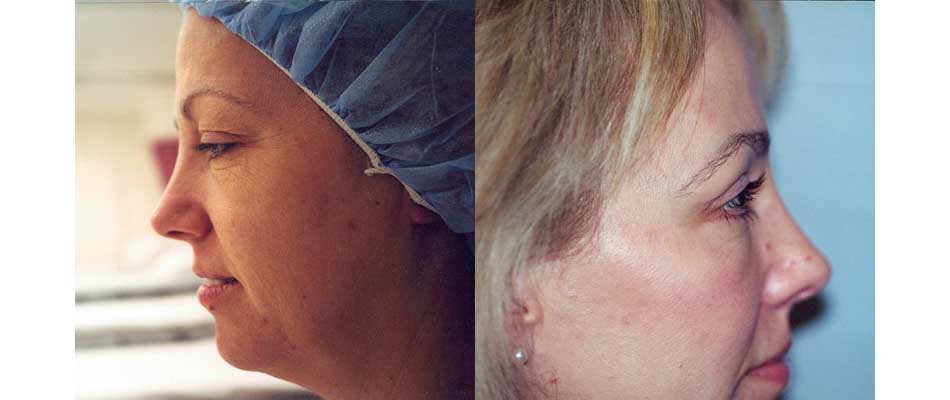Eyelid Surgery (Blepharoplasty)
Do you think you looker older than you should because of drooping eyelids or “pillows” under your eyes? Signs of aging tend to show up around our eyes first and usually long before we’re ready!
Eyelid lift surgery can restore your eyelids to their previous, more youthful position, erasing those early signs of aging. And droopy eyelid surgery can be done along with other rejuvenating procedures like a facelift or browlift for a complete refresh.
What Is a Blepharoplasty?
Blepharoplasty is a surgical procedure to correct drooping eyelids by removing excess fat, muscle, and skin. It’s performed for cosmetic reasons but also to restore your field of vision. As we age, the muscles around the eyes weaken while the eyelids stretch.
Fat can accumulate above and below the eyelids, resulting in bags under your eyes and sagging eyebrows and upper lids. The result can be a droopy, sleepy look that can narrow your field of vision, especially your peripheral vision.
How Does It Work?
Blepharoplasty can be performed on the upper and lower lids.. Excess skin and fat are removed or repositioned to improve peripheral vision and make your upper face look younger and more alert.
It can address:
- Bags under the eyes
- Drooping lower eyelids
- Droopy skin that impairs vision
- Extra skin and fine wrinkles under the eye
- Puffiness in the eyelids caused by fatty deposits
- Sagging or loose skin that changes the contour of the upper eyelid
Good Candidates for a Blepharoplasty
Every cosmetic procedure is customized based on many factors. At your initial consultation, we’ll discuss your goals, expectations, medical history, and likely outcome.
A good candidate for eyelid surgery is someone who:
- Doesn’t have an eye disease like glaucoma or dry eye
- Doesn’t have chronic conditions that affect wound healing or blood clotting
- Doesn’t smoke
- Has realistic goals, is optimistic
- Is in overall good health
- Is unhappy with bags under the eyes or sagging eyebrows
The Procedure
Before surgery, you may be asked to stop smoking and stop taking medications that can cause or worsen bleeding. You should plan to limit your activity for several days after your procedure.
On the day of the procedure, you will need to bring someone with you to drive you home. You may also want to have someone stay with you the first night home.
- You may have local anesthesia or IV sedation.
- Your surgeon will take care to place incisions along the natural lines of your lids to remove the excess fat and skin. The procedure may take about an hour or two for double eyelid surgery.
- The incisions will be closed with tiny stitches. Lower lids often don’t need stitches.
- You’ll be taken to a separate room to recover. While in recovery, you may have ointment in your eyes to reduce dryness and cold packs to help reduce swelling.
- When you’re cleared to go home, your doctor will give you instructions for self-care at home.
Eyelid surgery recovery may include some swelling and bruising, but it will typically clear up within a week or two. It’s important to wear dark sunglasses to protect your incisions until you are completely healed.
Results typically last from five years to a lifetime. Lower lid surgery typically lasts a lifetime.
Cost of Eyelid Surgery
Cost is an important factor in any cosmetic procedure but choosing a surgeon you feel comfortable with is essential. You’ll feel more at ease throughout the entire process if you have confidence in your surgeon.
Insurance companies typically won’t cover cosmetic procedures but may cover blepharoplasty if it’s medically necessary to restore your vision. Your insurance company may require you to see a board-certified eye doctor for verification with a visual test.
Eyelid surgery costs may vary based on your individual needs and other factors. The total cost usually includes all related fees, including:
- Anesthesia
- Location
- Medical tests
- Prescriptions
- The surgeon’s fee
Risks
Like any surgical procedure, blepharoplasty has certain risks. Problems are rare but may include:
- Abnormal folding of the skin
- Anesthesia reactions
- Bleeding
- Blood clots
- Discoloration in the surrounding skin
- Displaced lower lash line
- Dry eyes
- Eyelid problems like difficulty closing your eyes
- Infection
- Injury to the eye muscles
- Loss of eyesight (rare)
- Need for additional surgery
- Scarring
- Temporarily blurry vision
- Most patients have safe and successful surgeries and are very happy with their results!
Don’t wait to restore your youthful appearance and a full field of vision – schedule a free consultation today!










